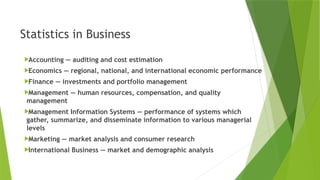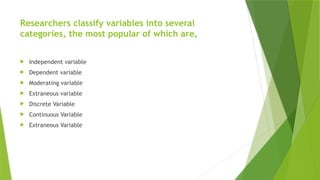Introduction to Statistics statistics formuls
- 2. What is Statistics? - Science of gathering, analyzing, interpreting, and presenting data - Branch of mathematics - Course of study - Facts and figures - Measurement taken on a sample
- 3. Definitions “Statistics is a science of estimates and probabilities” “Statistics are numerical statement of facts in any department of enquiry placed in relation to each other.” “Statistics may be defined as the collection, presentation, anlaysis and interpretation of numerical data.”
- 4. Role/functions of Statistics Summarization Comparison Forecasting Estimation Tests of Hypothesis
- 5. Statistics in Business Accounting — auditing and cost estimation Economics — regional, national, and international economic performance Finance — investments and portfolio management Management — human resources, compensation, and quality management Management Information Systems — performance of systems which gather, summarize, and disseminate information to various managerial levels Marketing — market analysis and consumer research International Business — market and demographic analysis
- 6. Population Versus Sample Population — the whole a collection of persons, objects, or items under study Sample — a portion of the whole a subset of the population
- 7. Population
- 8. Population and Census Data Identifier Color MPG RD1 Red 12 RD2 Red 10 RD3 Red 13 RD4 Red 10 RD5 Red 13 BL1 Blue 27 BL2 Blue 24 GR1 Green 35 GR2 Green 35 GY1 Gray 15 GY2 Gray 18 GY3 Gray 17
- 9. Sample and Sample Data Identifier Color MPG RD2 Red 10 RD5 Red 13 GR1 Green 35 GY2 Gray 18
- 10. Descriptive vs. Inferential Statistics Descriptive Statistics — using data gathered on a group to describe or reach conclusions about that same group (population) only Inferential Statistics — using sample data to reach conclusions about the population from which the sample was taken
- 11. What is Data? Definition: Facts or figures, which are numerical or otherwise, collected with a definite purpose are called data. Everyday we come across a lot of information in the form of facts, numerical figures, tables, graphs, etc. These are provided by newspapers, televisions, magazines and other means of communication. These may relate to cricket batting or bowling averages, profits of a company, temperatures of cities, expenditures in various sectors of a five year plan, polling results, and so on. These facts or figures, which are numerical or otherwise, collected with a definite purpose are called data.
- 12. Levels of Data Measurement 1. Nominal — Lowest level of measurement 2. Ordinal 3. Interval 4. Ratio — Highest level of measurement
- 13. Nominal Level Data Numbers are used to classify or categorize Example: Employment Classification 1 for Educator 2 for Construction Worker 3 for Manufacturing Worker Example: Ethnicity 1 for African-American 2 for Anglo-American 3 for Hispanic-American
- 14. Ordinal Level Data Numbers are used to indicate rank or order Relative magnitude of numbers is meaningful Differences between numbers are not comparable Example: Ranking productivity of employees Example: Taste test ranking of three brands of soft drink Example: Position within an organization 1 for President 2 for Vice President 3 for Plant Manager 4 for Department Supervisor 5 for Employee
- 15. Example of Ordinal Measurement f i n i s h 1 2 3 4 5 6
- 16. Ordinal Data Faculty and staff should receive preferential treatment for parking space. 1 2 3 4 5 Strongly Agree Agree Strongly Disagree Disagree Neutral
- 17. Interval Level Data Distances between consecutive numbers have meaning and the data are always numerical. Relative magnitude of numbers is meaningful Differences between numbers are comparable Zero is just another point on scale and does not mean the absence of Value. Example: Fahrenheit Temperature Example: Calendar Time Example: Percentage return on stock.
- 18. Ratio Level Data Highest level of measurement Relative magnitude of numbers is meaningful Differences between numbers are comparable Zero value in data represents the absence of the characteristic being studied. Examples: Height, Weight, and Volume Example: Monetary Variables, such as Profit and Loss, Revenues, and Expenses Example: Financial ratios, such as P/E Ratio, Inventory Turnover, and Quick Ratio.
- 19. Usage Potential of Various Levels of Data Nominal Ordinal Interval Ratio
- 20. Data Level, Operations, and Statistical Methods Data Level Nominal Ordinal Interval Ratio Meaningful Operations Classifying and Counting All of the above plus Ranking All of the above plus Addition, Subtraction, Multiplication, and Division All of the above Statistical Methods Nonparametric Nonparametric Parametric Parametric
- 21. Types of Variables In statistics and research, variables are items that you can measure, modify, and control. In research, variables are the factors that are manipulated to measure their effects on an outcome variable. A variable is any characteristic of an individual, group, organization or social phenomenon that changes. A variable is something which varies and can have more than one value. A Variable is attribute or characteristic of an entity.
- 22. Example of Variable 1- Suppose lets take organization as an example. Organization is an entity. Name, Size, Type, Learning, Innovation are the attributes of an organization. So all these attributes are the variables. 2- Other example is that Employee is also an entity. Name, Age, Gender, Experience, Stress level, satisfaction, Performance are the attributes of an employee. So all these attributes are the variables.
- 23. Researchers classify variables into several categories, the most popular of which are, Independent variable Dependent variable Moderating variable Extraneous variable Discrete Variable Continuous Variable Extraneous Variable
- 24. Independent variable The variable that is manipulated to measure its effects on an outcome variable. The independent variable is the factor that the researcher purposely change or control in order to see what effect it has. The variable which causes affect on dependent variable. It is also called predictor or explanatory variable. Example of Independent Variable The amount of sugar, added to each cup of orange juice.
- 25. Dependent Variable The dependent variable is a variable that represents the experiment’s outcome. The variable that is measured in order to determine the effect of an independent variable. The dependent variable is the variable being measured. It is affected by the change in Independent variable. It is also called criterion or outcome variable. Example of Dependent Variable Any measurement, of human health, and growth.
- 26. Moderating Variable A moderating variable, also known as a moderator variable, modifies the link between dependent and independent factors by strengthening or diminishing the effect of the mediating variable. Moderating variables are those that moderate or change the relationship between the independent and dependent variable. It is the variable that effects the relationship between independent variable and dependent variable. This variable either weaken or strengthen the relationship of IV and DV. Example of Mediating Variable While social media use can predict isolation, this association may be higher in teens than in older persons. Age is a moderator here.
- 27. Discrete Variable Any numerical variables, you can realistically count. Discrete variables are those that can only take on a limited number of values. In research, discrete variables are often used to represent categorical data, such as gender or race. Discrete variables are often represented by integers. Example of Discrete Variable 1- As an example, consider the money in your pocket or the funds in your savings account.
- 28. Continuous Variable A continuous variable is a variable that can take on any value within a certain range. In research, a continuous variable is often used to measure things like opinion or behavior. Continuous variables are important because they allow researchers to get more detailed information about a population. Continuous variables are also useful for measuring change over time. Example of Continuous Variable 1- If researchers want to know how people feel about a new product, they can use a continuous variable to measure how much people like the product on a scale of 1 to 10. 2- If researchers want to know whether people’s opinions about a product are changing, they can use a continuous variable to measure how people’s opinions change from month to month.
- 29. Extraneous Variable Extraneous variables are factors that affect the dependent variable but were not originally considered by the researcher while designing the experiment. These unexpected variables can alter the outcomes of a study or how a researcher perceives the results. Example of Extraneous Variable A study could be conducted to determine if private tutoring or online courses are more helpful at improving students’ Spanish test scores. Parental support, prior understanding of a foreign language, or socioeconomic background are examples of extraneous elements that may unintentionally influence the outcome.




























